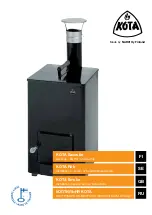
mounted with the transmitter/receiver on one wall and the
reflector on the opposite wall, or both suspended from the
ceiling, or any wall/ceiling combination. In the case of the
ceiling mount, the distance from the end walls should not
exceed one-quarter of the selected spacing (7.5 ft. [2.3m]
maximum if the spacing is 30 ft. [9.1m]). See Figure 2.
Figure 1. Spacing for smooth ceiling (side view):
C0254-00
Figure 2. Spacing for smooth ceiling (top view):
16 ft. (5m) Mini mum
328 ft. (100m) Maximum
Tx/Rx
Reflector
S
Tx/Rx
Reflector
1/2 S Maximum
1/4 S
Max.
C0255-00
In the case of peaked or sloped ceilings, codes may specify
spacing of detectors by using horizontal spacing from the
peak of the roof or ceiling. Figures 3 and 4 show the spacing
for both the shed type and peaked type sloped ceilings.
On smooth ceilings, beam smoke detectors should gener-
ally be mounted between 12 and 18 inches (0.3 to 0.46m)
from the ceiling. In many cases, however, the location and
sensitivity of the detectors shall be the result of an engi-
neering evaluation that includes the following: structural
features, size and shape of the room and bays, occupancy
and uses of the area, ceiling height, ceiling shape, surface
and obstructions, ventilation, ambient environment, burn-
ing characteristics of the combustible materials present,
and the configuration of the contents in the area to be
protected.
Figure 3. Sloped ceiling (shed type):
S
3 ft. (0.
9m)
Max.
S
1/2 S MAX.
Tx/Rx
Reflector
C0256-00
Figure 4. Sloped ceiling (peaked type):
1/2 S
S
S
1/2 S
3 ft. (0.9m)
Max.
3 ft. (0.9m
)
Max.
Mount Detector
Anywhere in This Area
Tx/Rx
Reflector
C0257-00
Mounting Locations
Beam detectors require a stable mounting surface for
proper operation. A surface that moves, shifts, vibrates, or
warps over time will cause false alarm or trouble condi-
tions. Initial selection of a proper mounting surface will
eliminate false alarms and nuisance trouble signals.
Mount the detector on a stable mounting surface, such as
brick, concrete, a sturdy load-bearing wall, support col-
umn, structural beam, or other surface that is not expected
to experience vibration or movement over time. DO NOT
D400-74-00
4
I56-2542-00R


































